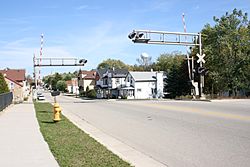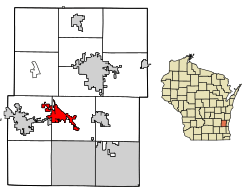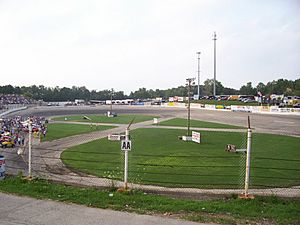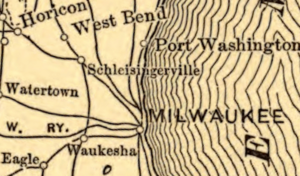Slinger, Wisconsin facts for kids
Quick facts for kids
Slinger, Wisconsin
|
|
|---|---|

Facing NE near the railroad tracks
|
|
| Nickname(s):
Village of the Seven Hills
|
|

Location of Slinger in Washington County, Wisconsin.
|
|
| Country | |
| State | |
| County | Washington |
| Incorporated | 1869 |
| Area | |
| • Total | 5.26 sq mi (13.63 km2) |
| • Land | 5.24 sq mi (13.57 km2) |
| • Water | 0.02 sq mi (0.06 km2) |
| Elevation | 1,063 ft (324 m) |
| Population
(2020)
|
|
| • Total | 5,992 |
| • Density | 1,062.02/sq mi (410.07/km2) |
| Time zone | UTC-6 (Central (CST)) |
| • Summer (DST) | UTC-5 (CDT) |
| Area code(s) | 262 |
| FIPS code | 55-74400 |
| GNIS feature ID | 1574278 |
Slinger, once known as Schleisingerville, is a village located in Washington County, Wisconsin, in the United States. In 2020, about 5,992 people lived there. Slinger is also on the edge of the larger Milwaukee area.
Contents
Why Slinger is Called Slinger
The village was first named Schleisingerville. This name honored Baruch Schleisinger Weil, a businessman and politician. He helped develop the community as a train stop in the 1840s and 1850s.
People living there often shortened the long name to "Slinger." On May 3, 1921, the villagers voted to officially change the name to Slinger.
A Look at Slinger's Past
In the early 1800s, the Slinger area was home to the Potawatomi Native American people. They gave up their land to the United States government in 1833. Many Potawatomi moved west, but some stayed in Wisconsin.
One group of Potawatomi, led by Chief Kewaskum, lived near Pike Lake, west of Slinger. Chief Kewaskum was friendly with the white settlers who started arriving in the 1840s. The nearby Village of Kewaskum was named after him. Some Potawatomi lived in Washington County until the late 1800s. Many of them later formed the Forest County Potawatomi Community in northern Wisconsin.
How Slinger Started
Baruch Schleisinger Weil, an immigrant from France, helped start the village. On November 1, 1845, he bought 2,000 acres of land in Washington County. He soon built a general store for local farmers, loggers, and Native Americans. He also opened a distillery.
Other businesses, like blacksmiths and shoemakers, began to settle in the area. The community was named "Schleisingerville" to honor Weil. For its first 20 years, the community was part of the Town of Polk.
Growth with the Railroad
In 1850, Weil opened a post office. In 1855, he worked to bring the La Crosse and Milwaukee Railroad through the community. The train line was finished on August 23, 1855.
The village grew because of these train connections. In 1869, it officially became a village, taking some land from the Town of Polk. For many years, Slinger was mostly a farming community. Most businesses served farmers and local residents.
German Culture and Modern Times
In its early years, Slinger had a strong German culture. The first Catholic church opened in 1862, and the first Lutheran church opened in 1863. In the late 1800s and early 1900s, the village had a German club called a Turnverein. It also had a German newspaper called Der Botschafter, which means The Messenger.
After World War II, Slinger saw more big industries move in. One example is the Slinger Foundry Company, which makes parts for companies like Briggs & Stratton and Harley-Davidson. Between 1970 and 2000, Slinger's population grew quickly. The area around it also became more like a suburb.
Slinger's Location and Landscape
Slinger is located at 43°19′42″N 88°17′0″W / 43.32833°N 88.28333°W.
The village has a total area of about 5.31 square miles (13.75 square kilometers). Most of this area is land, with a small amount of water.
Slinger is known as the "village of seven hills." This is because it sits in the middle of the Kettle Moraine, a hilly area formed by glaciers.
Slinger's Weather
|
||||||||||||||||||||||||||||||||||||||||||||||||||||||||||||||||||||||||||||||||||||||||||||||||
People Living in Slinger
| Historical population | |||
|---|---|---|---|
| Census | Pop. | %± | |
| 1880 | 358 | — | |
| 1890 | 432 | 20.7% | |
| 1900 | 549 | 27.1% | |
| 1910 | 538 | −2.0% | |
| 1920 | 730 | 35.7% | |
| 1930 | 769 | 5.3% | |
| 1940 | 775 | 0.8% | |
| 1950 | 919 | 18.6% | |
| 1960 | 1,161 | 26.3% | |
| 1970 | 1,216 | 4.7% | |
| 1980 | 1,612 | 32.6% | |
| 1990 | 2,340 | 45.2% | |
| 2000 | 3,901 | 66.7% | |
| 2010 | 5,068 | 29.9% | |
| 2020 | 5,992 | 18.2% | |
| 2022 (est.) | 6,294 | 24.2% | |
| U.S. Decennial Census | |||
Slinger's Population in 2010
According to the census from 2010, there were 5,068 people living in Slinger. There were 2,029 households and 1,390 families.
Most of the people in Slinger were White (97.2%). A small number were African American (0.5%), Native American (0.2%), or Asian (0.6%). About 2.3% of the population was Hispanic or Latino.
About 36.1% of households had children under 18 living with them. Most households (52.7%) were married couples living together. The average household had 2.48 people, and the average family had 2.99 people.
The average age in the village was 37.2 years old. About 26.4% of residents were under 18, and 10.3% were 65 or older. The population was almost evenly split between males (49.0%) and females (51.0%).
Fun Things to Do in Slinger

- Little Switzerland Ski area is located in Slinger, offering winter sports fun.
- Slinger is home to the Slinger Speedway, which is known as the world's fastest quarter-mile paved oval racetrack.
- The village also has a 1.14-acre splash pad, a great place to cool off.
Schools in Slinger
Slinger is served by the School District of Slinger. The schools include:
- Slinger Elementary School
- Allenton Elementary
- Addison Elementary
- Slinger Middle School
- Slinger High School
Slinger also has St. Peter Catholic School, which is a private elementary school.
See also
 In Spanish: Slinger (Wisconsin) para niños
In Spanish: Slinger (Wisconsin) para niños


